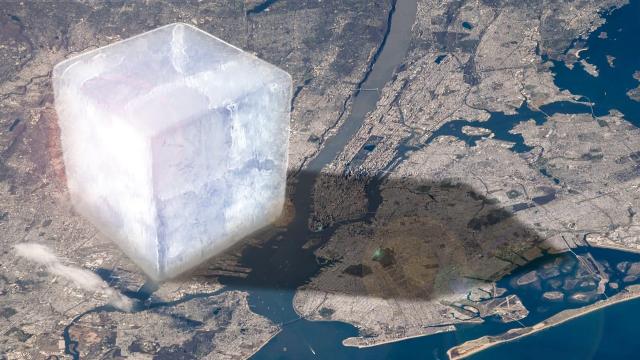We talk about ice a lot here on Earther — or more specifically, the growing absence of it. A new study puts what’s happening to the planet in striking perspective. While I can tell you the results show 1.2 trillion tons of ice disappeared every year since 1994, it’s a lot easier to grasp as a visual.
That cube of ice up there towers 10 kilometres into the sky like a sunshade over Manhattan and stretches over a huge swath of New Jersey, from Newark Airport to Jersey City. That’s how much we’ve lost to burning fossil fuels on average per year over the past two decades. The skyscrapers of the Financial District and Midtown are toothpicks. More ominously, the cube is getting bigger as ice loss accelerates.
The ice cube illustration is tied to a study published in the Cryosphere on Monday that looks at, uh, the state of the cryosphere. A team of scientists from across the UK used satellite measurements and climate models to explore what’s happening to every nook and cranny of ice around the globe. While most studies focus on either sea ice or ice on land, the new paper looks at both to give us a better understanding of how much ice has melted due to climate change.
“There has been a huge international effort to study individual regions, such as glaciers spread around the planet, the polar ice sheets in Greenland and Antarctica, the ice shelves floating around Antarctica, and sea ice drifting in the Arctic and Southern oceans,” Tom Slater, the study’s lead author and ice researcher at the University of Leeds, said in an email. “We felt that there was now enough data to be able to combine these efforts and examine all the ice being lost from the planet.”
The results show Arctic sea ice is the fastest-disappearing ice on the planet. A staggering 6.9 trillion tonnes have turned to liquid from 1994 to 2017, the period for which the study had data. That was followed by Antarctic ice shelves, which have seen 5.9 trillion tonnes of ice vanish, sometimes in catastrophic fashion. The most recent example is Iceberg A68, a Delaware-size piece of ice that ripped off the Larsen C ice shelf in 2017 and has since wandered the Southern and Atlantic oceans. It most recently had a near run-in with an ecologically sensitive island.
But other, more insidious forms of ice shelf drama are afoot. The study doesn’t just look at ice area; it also looks at ice volume. And the most shocking impacts on ice shelves are happening beneath the surface. Ice shelves jut out over the ocean, holding back glaciers on ice sheets on land. But in West Antarctica, satellite and direct observations show warm water has been eating away at ice shelves and could eventually cause them to collapse. If that happens, sea level rise will accelerate and won’t stop for centuries; the ice in West Antarctica could raise seas by more than 3 metres.
Glaciers on land in Alaska, the Himalayas, and elsewhere are also major drivers of sea level rise, as are the glaciers and ice sheets of Greenland. They’re all disappearing at an alarming rate. The threat of water loss in regions that rely on glacier and snowmelt is certainly an acute concern. So, too, is the disappearance of sea ice and its impact on traditional ways of life in the Arctic. And incremental but quickening sea level rise can play out in dramatic fashion when hurricanes roar ashore, pushing storm surge farther inland thanks to the climate change-driven boost. Perhaps most ominously, the melt is just a tiny aspect of the changes happening.
“We found that it took only about 3% of the excess heat created by greenhouse gas emissions to melt all this ice, a surprisingly small amount of energy to melt such a large amount of ice, which has a disproportionately large effect on our environment,” Slater said.
In that light, the giant ice cube from hell is showing just a tiny portion of the impact of human activities on the planet.
